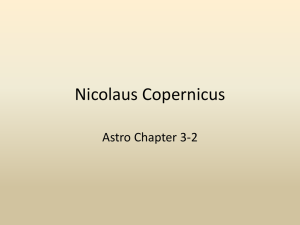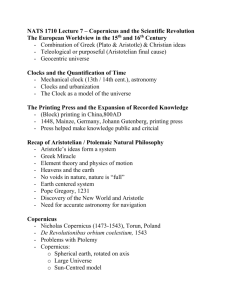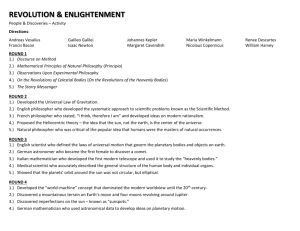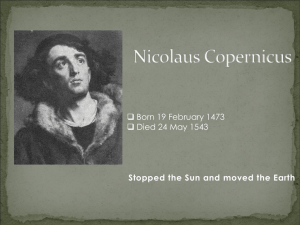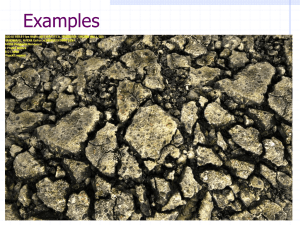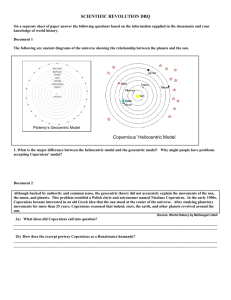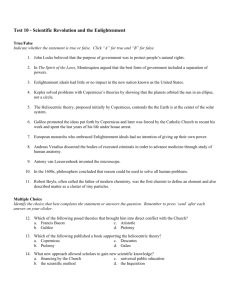Lesson 0: What is progress
advertisement
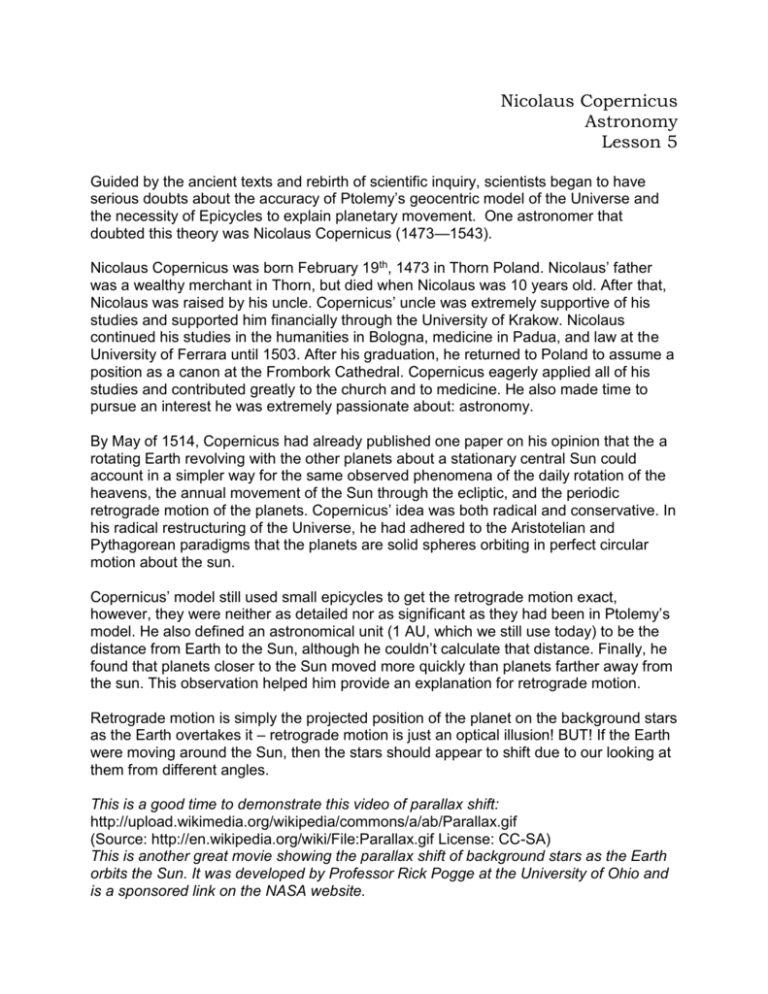
Nicolaus Copernicus Astronomy Lesson 5 Guided by the ancient texts and rebirth of scientific inquiry, scientists began to have serious doubts about the accuracy of Ptolemy’s geocentric model of the Universe and the necessity of Epicycles to explain planetary movement. One astronomer that doubted this theory was Nicolaus Copernicus (1473—1543). Nicolaus Copernicus was born February 19th, 1473 in Thorn Poland. Nicolaus’ father was a wealthy merchant in Thorn, but died when Nicolaus was 10 years old. After that, Nicolaus was raised by his uncle. Copernicus’ uncle was extremely supportive of his studies and supported him financially through the University of Krakow. Nicolaus continued his studies in the humanities in Bologna, medicine in Padua, and law at the University of Ferrara until 1503. After his graduation, he returned to Poland to assume a position as a canon at the Frombork Cathedral. Copernicus eagerly applied all of his studies and contributed greatly to the church and to medicine. He also made time to pursue an interest he was extremely passionate about: astronomy. By May of 1514, Copernicus had already published one paper on his opinion that the a rotating Earth revolving with the other planets about a stationary central Sun could account in a simpler way for the same observed phenomena of the daily rotation of the heavens, the annual movement of the Sun through the ecliptic, and the periodic retrograde motion of the planets. Copernicus’ idea was both radical and conservative. In his radical restructuring of the Universe, he had adhered to the Aristotelian and Pythagorean paradigms that the planets are solid spheres orbiting in perfect circular motion about the sun. Copernicus’ model still used small epicycles to get the retrograde motion exact, however, they were neither as detailed nor as significant as they had been in Ptolemy’s model. He also defined an astronomical unit (1 AU, which we still use today) to be the distance from Earth to the Sun, although he couldn’t calculate that distance. Finally, he found that planets closer to the Sun moved more quickly than planets farther away from the sun. This observation helped him provide an explanation for retrograde motion. Retrograde motion is simply the projected position of the planet on the background stars as the Earth overtakes it – retrograde motion is just an optical illusion! BUT! If the Earth were moving around the Sun, then the stars should appear to shift due to our looking at them from different angles. This is a good time to demonstrate this video of parallax shift: http://upload.wikimedia.org/wikipedia/commons/a/ab/Parallax.gif (Source: http://en.wikipedia.org/wiki/File:Parallax.gif License: CC-SA) This is another great movie showing the parallax shift of background stars as the Earth orbits the Sun. It was developed by Professor Rick Pogge at the University of Ohio and is a sponsored link on the NASA website. http://www.astronomy.ohio-state.edu/~pogge/Ast162/Movies/parallax.mov Source: http://www.astronomy.ohio-state.edu/~pogge/Ast162/Movies/#parallax (University of Ohio) http://imagine.gsfc.nasa.gov/YBA/HTCas-size/parallax3-movie.html (NASA) License: Attribution to Rick Pogge Another activity that quickly demonstrates Parallax shift is holding your finger in front of your face and closing one eye and then another. This is similar to the planet in the Parallax Movie being on the left side of the star and then the right side of the star. But, no one observed a shift in the stars. So, the stars would have to be VERY far away, or Copernicus’ theory was just wrong. At the time, scientists felt that God would not have wasted so much space in the Universe, and there must be no shift at all and therefore, the Earth is not in motion. Astronomers now know that the stars are indeed very far away and telescopes are used to detect the small parallax shifts. Images used in this lesson: Nicolaus Copernicus portrait from Town Hall in Thorn – 1580 Source: http://www.frombork.art.pl/Ang10.htm License: Public Domain Copernicus’s Uncle, Lucas Watzenrode Source: http://en.wikipedia.org/wiki/File:%C5%81ukasz_Watzenrode.jp eg License: Public Domain Copernicus’ birthplace Source: http://en.wikipedia.org/wiki/File:CopernicusHouse.jpg License: CC-BY-SA, SteveMcCluskey Frombork Cathedral Source: http://en.wikipedia.org/wiki/File:Katedra_we_Fromborku.JPG License: GFDL Geocentric vs. Heliocentric Model of the Solar System Source: http://en.wikipedia.org/wiki/File:Geoz_wb_en.jpg License: CC-BY-SA Parallax Shift Source: http://en.wikipedia.org/wiki/File:Stellarparallax2.svg License: Public Domain


